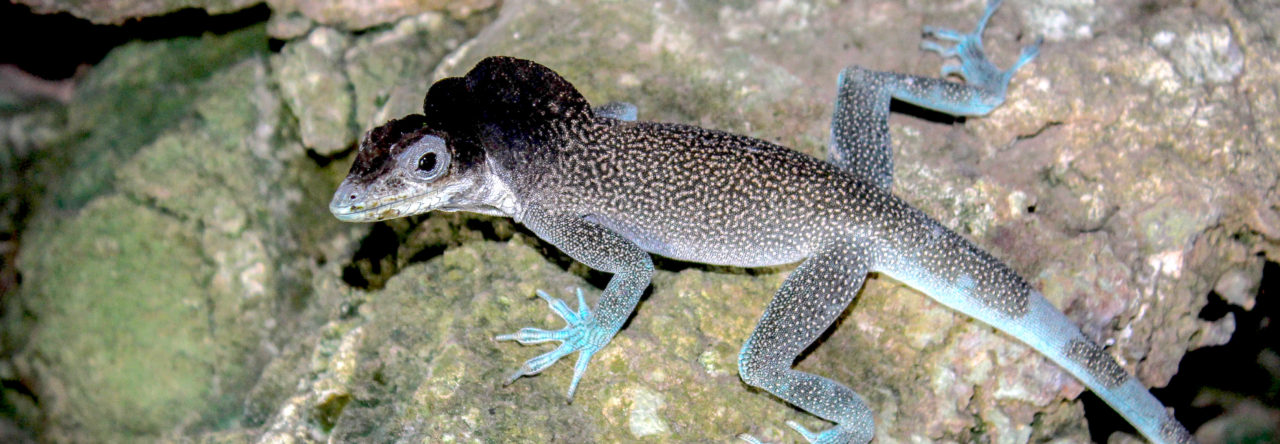AA correspondent Liam Revell reports from Puerto Rico:
For the past three weeks I have been running an activity with Jim Ackerman’s integrative ecology laboratory students that Jim has dubbed (perhaps with a touch of irony) the Great Anole Survey. The objective of this survey is to measure the species richness of anoles (three, it turns out) and the population density of the most common species (the Puerto Rican crested anole, Anolis cristatellus) in a small urban forest called Bosque Centenario on the Río Piedras campus of the University of Puerto Rico here in San Juan, Puerto Rico.
Over three capture sessions, with groups of students ranging between from about three to ten, we made 99 captures of 80 different adult male A. cristatellus in the 1.5 hectare area of Bosque Centenario. Bosque Centenario, as far as I can tell, is an abandoned, highly disturbed, open area or old sports field that consists of grassy area, some wetland, and patches of trees. Lizards were found mostly on trees, but were also observed using concrete and various PVC pipes as perches.
Our data collection ended last Friday, but we finally ran the numbers today. We used two methods to estimate the population size within this open forest patch. Due to variability in our collection effort by day, we first pooled sessions 1 & 2 into a single “marking” session in which 53 distinct animals were marked. We then treated the 3rd session, with 40 captures including 13 marked animals, as the “recapture” session and estimated the population size of adult males from these two numbers with the Petersen method (analysis 1). We also used only sessions 2 & 3 with the Petersen method (analysis 2), and finally the Schnabel method with all three mark and capture sessions (analysis 3).
By the Petersen method in analysis 1, we obtained a population size estimate of 157.1 (95% CI: 111.6, 235.6). In analysis 2, also using the Petersen method but with only data from mark & recapture sessions 2 & 3, we obtained a highly similar estimate, but with broader confidence limits, of N = 163.0 (114.7, 286.7). Finally, by the Schnabel method and using data from all three sampling sessions, we obtained an estimate of N = 147.8 (100.3, 255.3).
Given that this population estimate is from an area that Google Maps area calculator’s suggests is no more than about 1.5 hectares in size, this is quite an impressive number. The only prior study to quantitatively estimate population density of Anolis cristatellus in its native range is Genet (2002), and they found maximum densities of 68.0 male Anolis cristatellus per hectare – well below our lowest estimate of 147 individuals in 1.5 hectares, or about 98 adult males per hectare. That study also obtained population density estimates for juveniles and females, which they found to be significantly more dense than males – and I would guess that this is also true of our site (although we didn’t measure it).
Finally, some potential limitations include the fact that the Schnabel & Petersen estimators both assume a closed population. Our population is technically ‘open’ – but anyone that has studied adult male A. cristatellus knows that in the span of a few weeks, adult males are not going very far! We no doubt violated other assumptions of the method with our sampling protocol, but I will note that we marked 80 unique adult males in 1.5 hectares, and plenty of unmarked animals remained – so 150 in the whole plot seems more than reasonable, if not conservative.
For the record, the other two anoles we found in Bosque Centenario were Anolis pulchellus and the adaptable generalist A. stratulus.
- Evolution in Real Time on Lizard Island - March 23, 2025
- Spider Snags Adult Anolis osa - March 22, 2025
- An Homage to the Green Anoles of New Orleans - March 21, 2025



Skip Lazell
I think we have done densities of the same 3 species on Guana Island, BVI….
Did we not publish them? Check my book Island… and see. I have not got it here in China. Skip
Liam Revell
Hi Skip.
I was not aware of your study, but I think I found it: Rodda et al. 2001 in J. Trop. Ecol. correct? Therein you reported 1000/ha. & 1100/ha. density estimates for A. cristatellus in two different forest types. Excellent! Thanks for sharing this.
If we assume roughly the same ratio of adult males : total population size as reported in Genet (2002), we are nearing those kinds of numbers here at 400-800 animals / ha.
That being said, our estimate should be considered very rough – and keep in mind that lots of the habitat is open with few available perches, so the density probably varies quite widely through the plot. (E.g., everything in the background of the picture above is part of the area we sampled – including the open areas.)
Thanks again Skip.
– Liam
Skip Lazell
Great! Thanks! They are not scarce….. Onwards, Skip